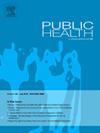父母的生活方式对学童食用超加工食品的影响。
IF 3.2
3区 医学
Q1 PUBLIC, ENVIRONMENTAL & OCCUPATIONAL HEALTH
引用次数: 0
摘要
研究目的评估巴西学龄儿童食用超标加工食品(UPF)与父母各种生活方式因素之间的关联:研究设计:以人口为基础的横断面研究,研究对象为 6-11 岁的亲子二人组:样本按比例分布于巴西各大区和学校类型。采用 "滚雪球 "技术进行招募,参与者填写在线问卷。首先,家长提供了有关教育、饮食习惯、食物消费标记、屏幕时间和体育活动的数据。随后,他们的子女使用《巴西学童食品消费图解问卷》报告了自己的 UPF 消费情况。儿童的 UPF 消费情况通过 NOVA 分数进行评估。进行了泊松回归对数线性分析(P 结果:这项研究共包括 2021 个儿童-家长二元组。平均而言,儿童在前一天摄入了 3.5 个 UPF。我们发现,儿童摄入较多的 UPFs 与父母的饮食习惯不太健康之间存在明显的关联(p 结论: 这些研究结果表明,巴西的学校和家庭之间存在一定的关系:这些研究结果表明,巴西学龄儿童的 UPFs 消费量与其父母的各种生活方式因素(尤其是饮食习惯、食物消费指标、屏幕时间和体育活动)之间存在关系。这凸显了家庭饮食环境对儿童在这一人生关键发育阶段的健康塑造的重要性,强调了将支持家庭生活方式因素纳入公共卫生政策的必要性。本文章由计算机程序翻译,如有差异,请以英文原文为准。
The effect of parents' lifestyle on Schoolchildren's consumption of ultra-processed food
Objectives
To assess the association between schoolchildren's consumption of ultra-processed foods (UPFs) and various lifestyle factors of their parents in Brazil.
Study design
Cross-sectional population-based study with parent-child dyads aged 6–11.
Methods
The sample was distributed proportionally across Brazilian macro-regions and type of school. Recruitment utilized the snowball technique, and participants filled in an online questionnaire. Initially, parents provided data on education, eating practices, food consumption markers, screen time, and physical activity. Subsequently, their children reported their UPF consumption using the Illustrated Questionnaire on Food Consumption for Brazilian Schoolchildren. The UPF consumption among children was assessed using the NOVA score. Poisson's regression log-linear analysis was performed (p < 0.05) with adjustments for macro-regions, type of school (as a proxy for socioeconomic status), gender, and age of the child.
Results
This study included a total of 2021 child-parent dyads. On average, children consumed 3.5 UPFs on the previous day. We found a significant association between high consumption of UPFs by the child and parents with less healthy eating practices (p < 0.05), excessive screen time (p < 0.05), and high UPF consumption (p < 0.05).
Conclusions
These findings demonstrate a relationship between Brazilian schoolchildren's consumption of UPFs and various lifestyle factors of their parents, particularly regarding eating practices, food consumption markers, screen time, and physical activity. This underscores the importance of the home food environment in shaping children's health during this critical developmental stage of life, emphasizing the need to incorporate support for family lifestyle factors into public health policies.
求助全文
通过发布文献求助,成功后即可免费获取论文全文。
去求助
来源期刊

Public Health
医学-公共卫生、环境卫生与职业卫生
CiteScore
7.60
自引率
0.00%
发文量
280
审稿时长
37 days
期刊介绍:
Public Health is an international, multidisciplinary peer-reviewed journal. It publishes original papers, reviews and short reports on all aspects of the science, philosophy, and practice of public health.
 求助内容:
求助内容: 应助结果提醒方式:
应助结果提醒方式:


